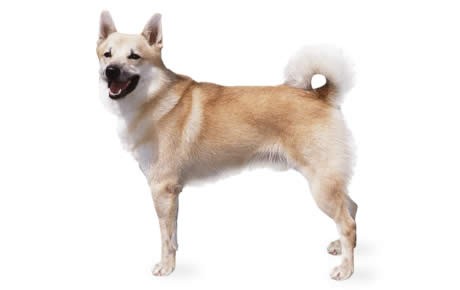Norwegian Buhund Breed Guide

Breed Group:
Herding Dogs
Get 30% off
Join our Newsletter
Sign Up Today
Norwegian Buhund Background & History
Known as a herder and a protector, the Norwegian Buhund is both a determined worker and a loyal friend. They are categorized as a Spitz-type dog and excel at all jobs that a dog can do. Back in historical times, the Norwegian Buhund served as the Vikings most cherished companions, accompanying them on all journeys whether it be by land or by sea.
Norwegian Buhunds stayed in Norway until they expanded to England and other nearby countries during the early 1900’s. While this breed eventually made it to the United States, they are still relatively unknown and are more popular in their homeland.
Norwegian Buhund Personality
The Norwegian Buhund is an intelligent breed that’s eager to please. Their greatest joy in life is when they have a job to do and a family to love. These dogs crave human companionship and have a devoted loyalty unmatched by most breeds. They can also be very alert, which makes them an excellent watchdog for the entire family. Most Norwegian Buhunds can be independent, but not to the point that makes them difficult to train. If they are left alone for a long period of time, chances are they will be just fine.
Norwegian Buhund Training Tips
Because the Norwegian Buhund is so intelligent, the canine training process is exceptionally easy. Simple tricks and commands are a breeze for these dogs, and they can even take on more challenging tasks that most breeds could not.
Since these dogs are obedient and quick to learn, they have been used in the police force and other professional personnel as trusted watchdogs and service dogs.
Norwegian Buhund Exercise Needs
The Norwegian Buhund is an active breed that requires vigorous exercise each and every day. Aside from a daily walk or two, they also enjoy lure coursing, obedience training, flyball, or herding. These pups are as active as can be and need an owner that can keep up with their high activity needs.
Norwegian Buhund Lifespan
On average, the Norwegian Buhund lives to be about 13 to 15 years old.
Norwegian Buhund Breed Popularity
The Norwegian Buhund is still fairly unknown in the United States today. It wasn’t until 2009 that this breed became recognized by the American Kennel Club and ranked as the 174th most popular breed in the United States.
Norwegian Buhund Feeding Requirements
The Norwegian Buhund requires a nutritious diet that satisfies their high energy needs. Keep in mind a dog’s feeding regimen should also consider the dog’s activity level, age, size, and metabolism. Make sure to choose a food that contains all -natural ingredients free from by-products, fillers, soy, and preservatives.
Norwegian Buhund Grooming
The coat of the Norwegian Buhund is thick and weather resistant, perfect to withstand the harsh winters of Norway. These thick coats are known to shed, so regular brushing and consistent grooming is a must to mitigate this issue.
Make sure to check and clean their ears every couple of weeks to avoid infection. Lastly, their nails should be trimmed regularly and bathed when needed.
Are Norwegian Buhunds Good with Kids?
These caring companions can be a child’s best friend as long as they both know how to properly interact with one another. Small toddlers may not be the best suited for a larger canine simply because they can be accidentally knocked over. Make sure if a child and dog are together an adult is around to supervise the interaction.
Norwegian Buhund Health Problems
Norwegian Buhunds are fairly healthy, however, they are still prone to several health complications. Possible health problems that can inflict your Norwegian Buhund include:
Hip dysplasia: This condition is one of the most common health problems that can affect any breed. Hip dysplasia in dogs occurs when the thighbone and hip socket do not fit how they should, which causes the joints to grind and rub against each other. This damage causes pain, lameness, and eventually arthritis.
Cataracts: Cataracts in dogs occurs when the lens of the eye begins to turn cloudy, which causes a progressive loss of vision. In severe cases, damaged cataracts can be replaced through corrective surgery.
Epilepsy: Canine epilepsy is the number one cause of seizures in dogs. This neurological disorder occurs when a dog suddenly falls to the ground, loses control over their mobility, and begins to shake. Seizures can last a few seconds to a few minutes and in some cases will recur. If you believe your dog has epilepsy, take him to your veterinarian as soon as possible.
Other Resources
National Breed Website: Norwegian Buhund Club of America
Rescues: Norwegian Buhund Rescue





